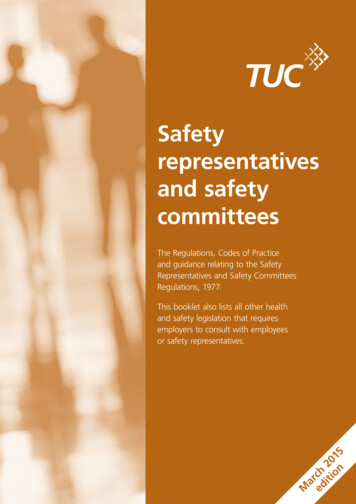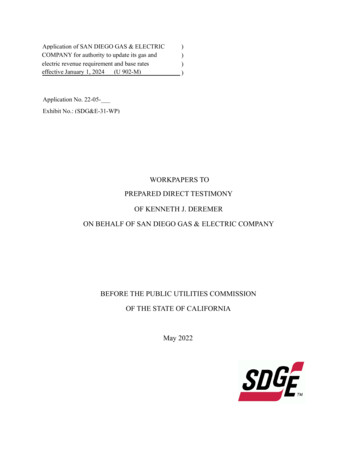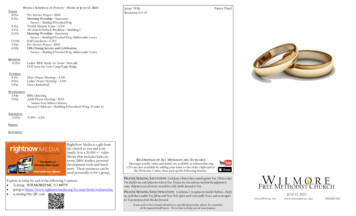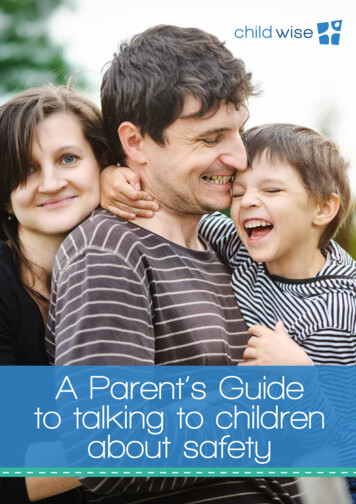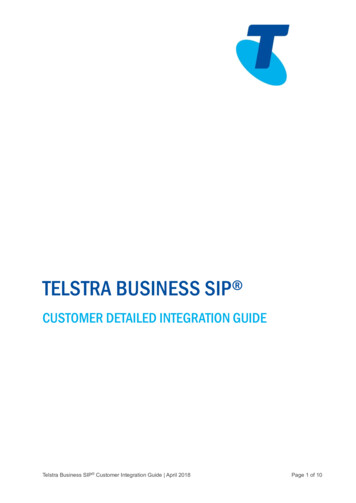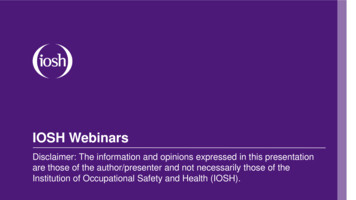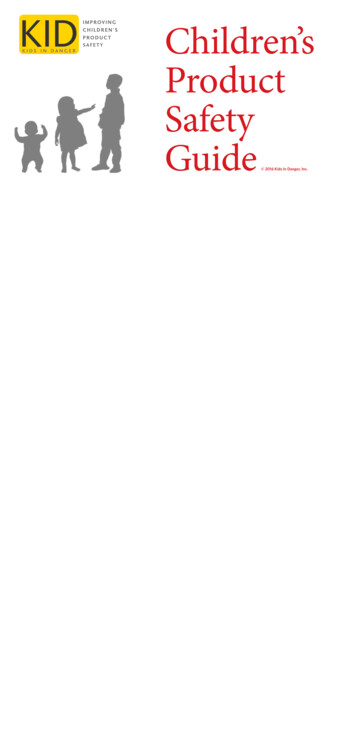
Transcription
Children’sProductSafetyGuide 2016 Kids In Danger, Inc.revised KID educational brochure.indd 16/5/16 9:38 PM
KID made this product safety guide with you and the childrenyou care for in mind. It can be used as a safety resource frombirth through childhood – or you can pick it up and flip right tothe page you need, whenever you need it.When you are done using the guide, please pass it on to another parent or caregiver with youngchildren to help spread awareness, share resources, and ultimately, keep kids safe!revised KID educational brochure.indd 26/5/16 9:38 PMTo order additional copies, please contact Email@KidsInDanger.orgThese icons will help guide you to the product safety information that is most relevantto the child’s age. Some pages have all 3 icons, meaning the information is important no matterwhat the child’s age.BabyToddlerChildInformationspecifically for childrenaged 0-1.Informationspecifically for childrenaged 1-3.Informationspecifically for childrenages 3 and up.How to use this guiderevised KID educational brochure.indd 36/5/16 9:38 PM
Recall ResourcesSometimes a problem arises with a product after it has reached themarket that can cause injury to consumers. The US Consumer Product Safety Commission (CPSC)works with the companies to announce a recall of these products. While many unsafe productsare recalled, many other unsafe products have not been recalled, and remain for sale and in usedespite their hazards. Children’s products are recalled every week. Below are resources to helpparents and caregivers keep up with recalls. To learn more about these unsafe products, visitKidsInDanger.org and follow us on social media.To learn more about children’s product safety, visit www.KidsInDanger.orgChild Product Recalls:Search your products for recalls at home by visiting CPSC.govrevised KID educational brochure.indd 46/5/16 9:38 PMgenerated at BeQRious.comTo search your products for recalls on the go,visit KidsInDanger.org from your smartphoneReport unsafe products and read product safety reports by consumers at SaferProducts.govCar Seat Recalls:Visit nhtsa.gov to search for car seat recalls and to receive recall notices by emailFood Recalls:Visit fda.gov to search for food recalls and to receive recall notices by emailFOOD5BabyToddlerrevised KID educational brochure.indd 5ChildRecall Resources6/5/16 9:38 PM
Safe Sleep GuidelinesStatement of Safe SleepA baby sleeps safest in a bare crib,play yard, or bassinet that hasn’tbeen recalled and meets the federalstandard. The crib shouldhave a tight fitting mattress witha fitted sheet only. Babies should beplaced on their backs and wearingfooted pajamas or wearableblankets when needed.To help prevent SIDS or suffocation, keep all items out of the crib, including:revised KID educational brochure.indd 6ToysHeavy BlanketsSleep positioners6/5/16 9:38 PMPillowsCrib bumper padsTop 3 Safe Sleep Tips: 1 Cribs manufactured after June 28, 2011, meetthe world’s strongest safety standard.2 Bare is best. Decorate the nursery, not the crib.3 Share the room, not the bed, with baby.7Babyrevised KID educational brochure.indd 7Safe Sleep Guidelines6/5/16 9:38 PM
Choking and IngestionHazardsYoung children learn from their environment by putting objects intotheir mouths. Here’s what to watch out for and actions to take to prevent choking or ingestionof dangerous items. For choking incidents, call 911 immediately.Test small parts and objects with an empty toilet paper tube. Anything thatfits in the tube is too small for a child under age 3.Watch for parts that might break off of a larger toy andpresent a choking hazard.Tiny, powerful earth magnets can damage internal organsif swallowed by attracting across tissues. It is hard to keep trackof these tiny magnets, so keep them out of homes withsmall children.revised KID educational brochure.indd 86/5/16 9:38 PMButton batteries can easily be swallowed and cause serious damageto the esophagus and gastrointestinal tract. If your child ingests a button battery, seekmedical attention immediately.Uninflated or broken balloons and piecescan cut off the respiratory airways if swallowed.CPR can inflate the balloon and make removal difficult.Keep uninflated or broken balloonsaway from children under age 8.If you suspect that a child has been exposed to apotentially harmful substance, don’t hesitate, call yourlocal Poison Center immediately. No issue or question toobig or too small, call any time of the day or night.9BabyToddlerrevised KID educational brochure.indd 9Choking and Ingestion Hazards6/5/16 9:38 PM
Tip-Over PreventionOne child dies every two weeks when a TV, a piece of furniture, or anappliance falls. Each year, on average, more than 22,000 children 8 years and younger aretreated for injuries related to furniture instability or tip-overs.To help prevent tip-over hazards, follow these simple,low-cost safety tips:nnnnnAnchor furniture to the wall or the floor with straps or brackets.Place TVs on sturdy low bases, or anchor the furniture and theTV on top of it. Push the TV as far back on the furniture as possible.Keep TV and cable cords out of reach of children.Keep remote controls and other attractive items off the TV stand so children won’tbe tempted to grab for them and risk knocking over the TV.Make sure free-standing ranges and stoves are installed with anti-tip brackets.In addition, other furniture items likehope chests, bean bag chairs, andbunk beds have entrapped and killedrevised KID educational brochure.indd 106/5/16 9:38 PMchildren. Locks should be removed andholes should be drilled in the chests.Zippers on bean bag chairs should bepermanently disabled. Remember whenchecking for recalls to look for furniturerecalls as well.Taking a few moments now toanchor and secure TVs, furniture andappliances can save your child from atip-over tragedy. For more information,visit www.ShanesFoundation.organd www.AnchorIt.gov.BabyToddlerrevised KID educational brochure.indd 11ChildTip-Over Prevention6/5/16 9:38 PM
Buy/Sell Safety ChecklistDangerous children’sproducts commonlyshow up in garagesales, church rummagesales, online (via sites such asCraigslist), and as hand-me-downs.When buying, selling, donatingor receiving second hand items,complete this safety checklist tohelp keep kids safe from unsafeproducts. If you are a seller,display this checklist and letyour customers know about yourcommitment to safety!Buy/Sell Safety Checklist:I’ve checked all products that I intend to buy/sell against the CPSC’s list of recalledproducts at www.CPSC.gov.revised KID educational brochure.indd 126/5/16 9:38 PMIf I am buying or selling a crib, I made sure that it was made after June 28, 2011, andtherefore meets the world’s strongest safety standard. Cribs made before that date do notmeet the standard and are not legal to resell.No items have broken or missing pieces (especially for items that need to be assembled,such as cribs).Baby bath seats or bath rings, baby walkers, crib bumper pads and sleep positioners arenot safe to use, so I will not buy/sell them.I have included/requested manufacturer info, instructions, and product registrationcards when possible. If not, these can sometimes be found on the manufacturer’s website.An online directory of manufacturer’s websites for product registration is available atwww.KidsInDanger.org/publications.Some products just shouldn’t be resold, including used car seats and bike helmets, so Iwon’t be buying/selling those.I made sure that children’s clothing doesn’t have drawstrings around the hood or neck.(If there are drawstrings, just pull them out, discard them, and the clothing is good to go!)Following these guidelines will help ensure that products aresafe to buy/sell. To check products for recalls on the go, visitwww.KidsInDanger.org from your smartphone.13BabyToddlerrevised KID educational brochure.indd 13ChildBuy/Sell Safety Checklist6/5/16 9:38 PM
Emerging HazardsNew products are constantly entering the market that can pose realdangers to children. Some of these products are intended for children but haven’t been tested tomeet strong federal safety standards. Other products are not intended for children but are affectingtheir safety. KID is working hard with other safety advocates to address these hazards so thechildren in your care are safe. To learn more about our advocacy work and to get involved, visitKidsInDanger.org/advocacySleep products intended for infant(1 year and under) that don’tmeet a federal safety standard:Sleep is one time a child is not necessarilysupervised, so it’s important that theproduct used during sleep is safe. Newinfant sleeping products are often availablefor purchase that haven’t been testedagainst established safety standards.Remember, a baby sleeps safest in a crib,play yard, or bassinet that hasn’t beenrecalled and meets the federal standard.Detergent packets: Ingestion of laundry detergent packets is on the rise inrevised KID educational brochure.indd 14recent years because of their appeal to young children (many mistakethem for candy or a teether) and the lack of child resistant packaging.If you have children under six, consider avoiding the use of laundrypackets. In all cases, keep them locked and out of the reach of children.6/5/16 9:38 PMLiquid Nicotine: Just ½ teaspoon of liquid nicotine foundin e-cigarettes can be deadly to a child. Kid friendly flavors,colors, and only recent requirements to use child resistantpackaging have contributed to the deaths of several children. FDA hasissued rules requiring child resistant packaging, but it isn’t on all products.To keep up with new emerging hazards, please visitKidsInDanger.org and follow us on social media.BabyToddlerrevised KID educational brochure.indd 15ChildEmerging Hazards6/5/16 9:38 PM
Managing yourProduct SafetyMost children’s products come with a product registration card.Completing the registration can prevent injury and save a life.Fast Facts about product registration:nnnWhat you can do:Product registration is the best way amanufacturer can contact you directly inthe event of a recall.nCannot be used for marketing or othercommercial purposesnMust be postage paidAs soon as you open the package ofa durable child’s product, fill out theregistration card and put it in the mail.If you don’t have the registration cardor if you prefer to register online, go tothe manufacturer’s site. A list of productregistration pages can also be found atKidsInDanger.org/publications.Use this form to track products you buy and use to care for your child.revised KID educational brochure.indd 166/5/16 9:38 PMCheck all products for recalls at www.CPSC.gov. If you give a product away or loan itto a friend or relative, make a note of who has it so you can contact them if it is recalled.Keep up with recalls by signing up for email alerts at www.CPSC.gov and monthlyupdates on children’s product safety news, including recalls, at www.KidsInDanger.org.Report any problems with your children’s products at www.SaferProducts.gov.Child Product Inventory SheetProductBabyToddlerrevised KID educational brochure.indd 17ManufacturerModel NumberDate PurchasedNotesManaging your Product Safety6/5/16 9:38 PM
How KID can be yourSafety ResourceKID has a variety of resources for parents, grandparents, healthcare professionalsand caregivers beyond the information contained in this booklet. Here are our top 5:1. WorkshopsOur workshop, Creating Safe Environments for Children, is an Illinois Gateways toOpportunity registry-approved training. Trainings are customizable to audienceand interest but cover topics including safe sleep, choking/ingestion hazards, andrecalls. If you or your organization is interested in hosting a workshop, pleasecontact KID at Email@KidsInDanger.org or 312-595-0649.B839762. Monthly Email AlertSign up for the KID Monthly Email Alert at www.KidsInDanger.org to stay informed about currentsafety news, recall updates, and other important information.3. Dowload Free Materials Visit the Publications section of our website to find resources in Englishand Spanish available for free download.4. Visit Kid.org Visit KidsInDanger.org to learn more.5. Social MediaFollow us on Facebook at www.facebook.com/KidsInDangerand onTwitter at www.twitter.com/KidsInDanger (@kidsindanger) to getlive updates of safety news, including recalls.revised KID educational brochure.indd 186/5/16 9:38 PM3 Steps to SafetyStep 1 – Learn about the problem – For general productsafety information, visit www.KidsInDanger.org.Step 2 – Check your products for safety – Do aninventory of the items used by children and check itagainst recalls at www.CPSC.gov.Step 3 – Act to keep kids safe by keeping up with recalls,reporting unsafe products, and by spreading the word.Stay informed on child product safety issues by signing up for safety alerts atwww.KidsInDanger.org and direct notification of recalls at www.CPSC.gov.Submit and view reports of unsafe children’s products at www.SaferProducts.gov.BabyToddlerChildHow KID can be your Safety e/d8/ad/d8ad4db1acrevised KID educationalbrochure.indd 19d0ef58354d1075728d36b0.png6/5/16 9:38 PM
Danny’s Story116 W. Illinois, Suite 4EChicago, IL InDangerpinterest.com/KidsInDangerOn May 12, 1998, 16-month-old Daniel Keysar wasstrangled to death at his licensed childcare facility when hisPlayskool Travel-Lite portablecrib collapsed, trapping his neckin the “V” of its folding rails.After his death, his parentsdiscovered that the crib hasbeen recalled 5 years earlier.Danny was also not the first, but the fifth victim of the crib.In total, these types of cribs have killed at least 19 children.Mobilizing their grief into a movement of positive change,Danny’s parents founded KID after they discovered their son’sdeath was not an accident, but a tragedy that occurred as theresult of a flawed system of product safety.Today, KID is working to reform the juvenile productsystem so that potentially dangerous products never reachthe marketplace. You can help KID continue to be the voicefor safer children’s products with a donation to KID atwww.KidsInDanger.org. Your financial support is critical forKID to continue its important work and help save lives.Funding for thisbooklet was providedby a generous grantfrom the AmericanLegion Child WelfareFoundation.revised KID educational brochure.indd 20KID’s mission is to promote the development ofsafer products, advocate for children, and educate the public,especially parents and caregivers, about children’s product safety.6/5/16 9:38 PM
Report unsafe products and read product safety reports by consumers at SaferProducts.gov Car Seat Recalls: Visit nhtsa.gov to search for car seat recalls and to receive recall notices by email Food Recalls: Visit fda.gov to search for food recalls and to receive recall notices by email Baby Toddler Child Recall Resources




